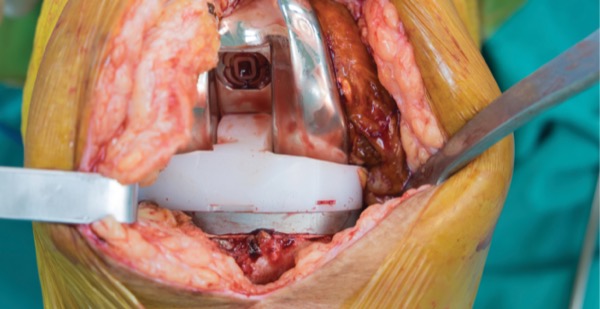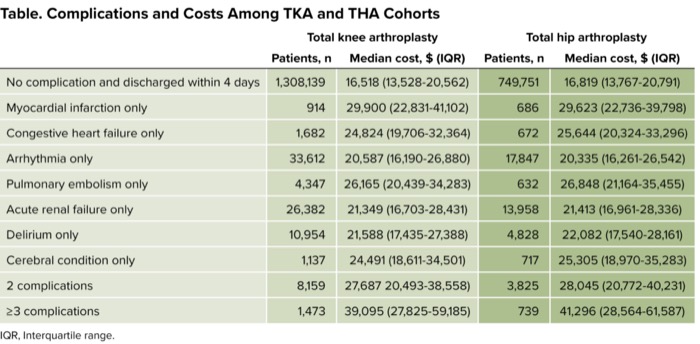SAN DIEGO—New research has quantified many anesthesiologists’ instincts when it comes to total joint arthroplasty (TJA): Patients with major postoperative complications cause significantly higher in-hospital costs than those who do not experience such setbacks.
The study concluded that even a single major complication event can make costs balloon from 30% to 100%, depending on the nature of the complication.
“Total joint arthroplasty is one of the most commonly performed procedures, yet the impact of major perioperative complications on its cost remains uncertain,” said Haoyan Zhong, a statistician at the Hospital for Special Surgery, in New York City. “We aimed to describe the association between major complications and the cost associated with this procedure.”
Dr. Zhong and her colleagues used the Premier Healthcare database to identify patients undergoing total hip (THA) and knee (TKA) arthroplasties between 2006 and 2021. Major complications were identified using ICD-9 and ICD-10 codes, and included myocardial infarction, congestive heart failure, arrhythmia, pulmonary embolism, acute renal failure, delirium and cerebral complications. The researchers calculated the gross total cost of treating each patient during the hospital encounter using a built-in variable from the Premier database; these costs were adjusted in 2022 U.S. dollars to account for inflation using the Consumer Price Index for medical care expenses.
Costs were stratified according to the number of complications experienced by patients, and then compared with a control group of patients who did not have any complications and were discharged within four days. Models were adjusted for demographic characteristics, type of insurance, comorbidity burden, year of surgery, hospital location, bed count and hospital teaching status.
Reporting at the 2024 spring meeting of the American Society of Regional Anesthesia and Pain Medicine (abstract 5258), Dr. Zhong noted that 3,241,624 TJA patients were identified in the database. Patients who developed any type of complication or multiple complications had higher costs than controls, as shown in the Table.
| Table. Complications and Costs Among TKA and THA Cohorts | ||||
| Total knee arthroplasty | Total hip arthroplasty | |||
|---|---|---|---|---|
| Patients, n | Median cost, $ (IQR) | Patients, n | Median cost, $ (IQR) | |
| No complication and discharged within 4 days | 1,308,139 | 16,518 (13,528-20,562) | 749,751 | 16,819 (13,767-20,791) |
| Myocardial infarction only | 914 | 29,900 (22,831-41,102) | 686 | 29,623 (22,736-39,798) |
| Congestive heart failure only | 1,682 | 24,824 (19,706-32,364) | 672 | 25,644 (20,324-33,296) |
| Arrhythmia only | 33,612 | 20,587 (16,190-26,880) | 17,847 | 20,335 (16,261-26,542) |
| Pulmonary embolism only | 4,347 | 26,165 (20,439-34,283) | 632 | 26,848 (21,164-35,455) |
| Acute renal failure only | 26,382 | 21,349 (16,703-28,431) | 13,958 | 21,413 (16,961-28,336) |
| Delirium only | 10,954 | 21,588 (17,435-27,388) | 4,828 | 22,082 (17,540-28,161) |
| Cerebral condition only | 1,137 | 24,491 (18,611-34,501) | 717 | 25,305 (18,970-35,283) |
| 2 complications | 8,159 | 27,687 20,493-38,558) | 3,825 | 28,045 (20,772-40,231) |
| =3 complications | 1,473 | 39,095 (27,825-59,185) | 739 | 41,296 (28,564-61,587) |
| IQR, Interquartile range. | ||||
Perhaps not surprisingly, the biggest additional cost in each surgical group was found in those patients who experienced at least three complications, followed by myocardial infarction only, which was more expensive than two complications. The highest cost of a single complication was for myocardial infarction, which was associated with 94% and 89% cost increases in TKA and THA, respectively, while the lowest cost complication was for arrhythmia only, which was associated with 28% and 27% cost increases in the two procedures.
“We conclude that major complications are associated with significantly higher in-hospital costs for TJA patients compared to those without complications,” Dr. Zhong said. “Even a single major complication can lead to an increase in costs ranging from 30% to almost 100%. Future studies are warranted to explore in detail the specific areas contributing to costs.”
Session moderator Sylvia H. Wilson, MD, said the study yielded interesting findings on the evolution of TJA over the past two decades.
“How we treat total joint arthroplasties changed dramatically between 2006 and 2021,” said Dr. Wilson, a professor of anesthesia and perioperative medicine at the Medical University of South Carolina, in Charleston. “These patients used to stay in the hospital, and now they’re in and out on the same day. Is it because we’re doing a better job getting them tuned up? You looked at the cost of complications, but what about the trend of complications over time? Are they decreasing or are we delivering improved care?”
“We looked at the trends of patients’ comorbidities when they come in for surgery and also after surgery,” Dr. Zhong replied. “We saw an increase in patients’ preoperative comorbidities over time, so I’m assuming they’re older and less healthy. But despite that, the complication rate has actually fallen over time. So, we’re doing a better job of treating these patients.
“We also looked at the total costs over time, and the costs of the two surgeries are getting lower,” Dr. Zhong added. “That could be because we’re having fewer complications or because we’re treating the complications more efficiently. This is something we have to explore further.”
Drs. Wilson and Zhong reported no relevant financial disclosures.



